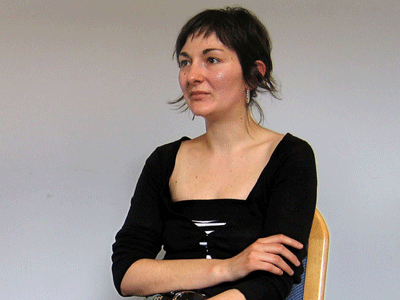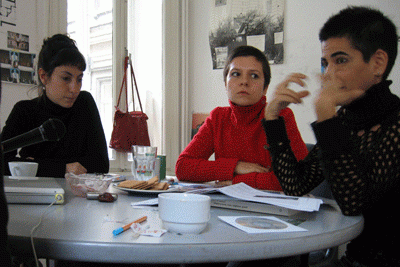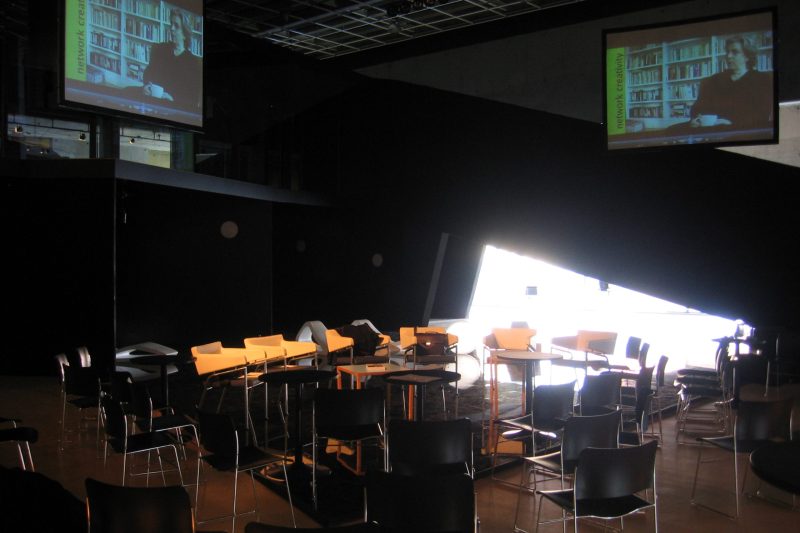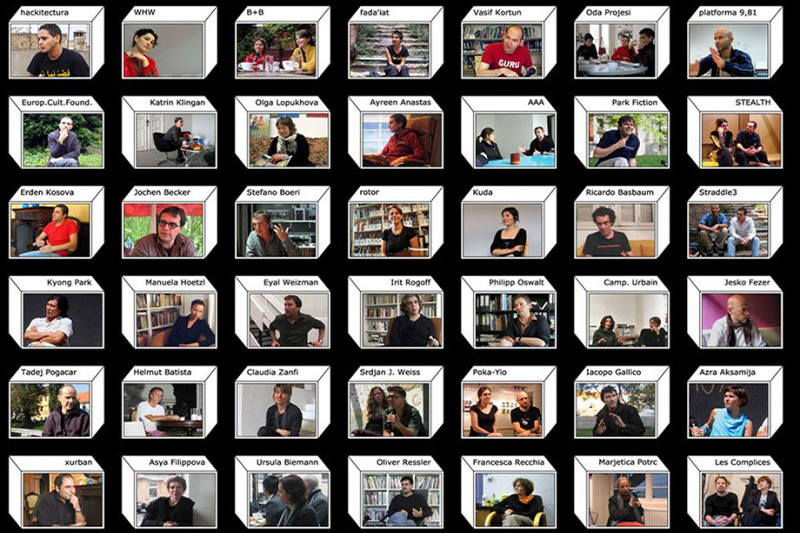- Interview
- Novi Sad
- 02.05.2006
- NETWORKED CULTURES
Conversation with Branca Ćurčić
Peter Mörtenböck/Helge Mooshammer: Kuda.org has become an important node in an alternative media network that is spreading across Europe and facilitating a direct exchange of information and ideas on a transnational level. How did the political situation in Serbia influence this particular format of combining new media art with political activism?
Branka Ćurčić: Basically, kuda.org was established in 2000 after what appeared to be democratic changes in the country. At the periphery this also meant the “democratic” redistribution of public funds and so more possibilities for cultural institutions to be funded by the state. Though this was just one of the factors triggering the establishment of kuda.org as a new cultural institution. There were actually many other reasons why it was initiated. The people who started it were already pursuing quite interesting art careers during the 1990s – e.g., Association Apsolutno (www.apsolutno.org), whose work, though exhibited abroad, was mainly related to contemporary art practices in Serbia during those hysterical war years. While participating in many exhibitions and events in Europe and the USA, the members of Apsolutno and later founders of kuda.org experienced one specific, let’s call it, consequence of today’s world, a world interconnected by communication technologies – the rise of small, independent initiatives dealing with different aspects of art, activism and new media.
What has been interesting about these practices is not their preoccupation with new media with respect to production, but rather their practice of analysing the consequences of new technologies on independent creative practices. What new possible forms of collectivity or organisation have emerged? Another reason for kuda.org might be seen in the attempt to counterbalance what was happening with contemporary art and its practices in Serbia during the 1990s, for in most cases this was very uncritical and self-centred. In contrast, kuda.org has not been about art production but about establishing a platform that is more oriented toward discussion and analysis. So the idea from the beginning was to energise space and create tension: we wanted to invite as many people as possible from the field of international art as well as new media practice and theory to present their views, explanations and experiences. It was not exclusively connected to new media. It also had a more political art context.
PM/HM: Can you expand on what it means to work collectively on political urgencies in terms of the actual projects you’ve been involved in, for instance, the Trans_European Picnic?
Branka Ćurčić: It’s interesting to have an international context, to work with people outside the country who can give you different kinds of input and new perspectives on your own practices. But, it’s also very important to work with people who are locally based, independent groups and artists, and so create the potential for local networking and a local scene. More and more of the people we’ve been working with have been, on the one hand, in institutions – official institutions – the Museum of Contemporary Art or the Cultural Centre of Novi Sad. We want to figure out what’s possible with official cultural institutions, especially when it comes to bigger projects, like organising the Trans_European Picnic or holding the World-Information.Org exhibition in Novi Sad. On the other hand, we try to create a balance between this and working with artists, youth groups and independent organisations that speak the same language as we do.
As far as the Trans_European Picnic project goes, it was very interesting for us to try to think about opposition to Europe, about being outside of the European Union. One friend defined this position as not-yet-EU (which in our case sounds ever more cynical as time passes). We were interested in seeing how such opposition came into being and established or re-established itself through different kinds of influences: historical background, heritage, the present political situation, growing markets, but also culture as an increasingly important unifier. For us, it was quite a big and uncertain event, and we were not really sure of the outcome. The idea was to do it in Novi Sad, which is still outside the EU, at the new border of this new Europe. In collaboration with V2_Institute for the Unstable Media from Rotterdam (www.v2.nl), we brought more than fifty different people together – artists and media activists from our own country, from the region and from different parts of Europe, not only the EU. In structure, it was a complex event, because we organised many public discussions, project presentations, screenings and performances, and ultimately this picnic that somehow wrapped up everything. Communication with the local population was very important to us, because it seemed that nobody knew or cared about what was going on with EU enlargement. There was not much public interest in things happening immediately outside the border, especially in the case of the former communist countries.
It was a quite interesting event with respect to heritage and the historical tensions that have always existed here. It enabled the discussion of diverse aspects of these issues. We also tried to introduce some historical facts about why this specific location was chosen as the site for the Trans_European Picnic. So we introduced the history of the Petrovaradin Fortress, which is located on the shore of the Danube in Novi Sad and was originally built to mark the border: it was a military construction for defending the Austrian-Hungarian Empire from the Ottomans. Before having our picnic there, which was also where Tito used to hunt, we went to the Chapel of Peace near Novi Sad. Built at the very end of the seventeenth century, just after peace was signed between Russia, Venice and the Austrian-Hungarian Empire on the one side, and the Ottoman Empire on the other, it’s actually a monument commemorating this event. The building is a rotunda with four entrances, symbolising the equality of the parties signing the treaty, which happened at a round table, the first ever used for such a diplomatic act. We’re at the border, an almost military site, but there are still some things about it that are more about coming together then dividing; though the event itself brought out many critical views on EU mobility and migration policies, labour organisation, and imperatives of cultural differences, etc.
PM/HM: It seems there are two levels of networks at stake: one is operating on the international level and the other toward the production of local platforms, such as your work with youth groups. How can art bring these different levels of organisation together? Do these two levels share an interface?
Branka Ćurčić: I’m pretty sure there are possibilities, big possibilities, for the two different levels to come together. In fact I think they’re doing so all the time through what we do. At times this is oriented more towards personal contacts; at other times, towards specific projects. I can’t comprehend all the possible levels of development of another network, so it’s very difficult to say. In one case, where we worked together with local youth groups, it somehow went very well, because a local network already existed. Some of our people already knew a few people on the other side, at the potential network, from another context (i.e., Susanne Lang and Florian Schneider). So we thought we should try to connect these young people and activists from Brandenburg with the Novi Sad crew – independent youth groups that are very anti-nationalist, an attitude of ever-greater urgency in Serbia as of late. This alone was motivation enough for people to start working together. Another question relates to how they in fact collaborate and whether it’s possible to talk about actual networks. Ultimately it seems to be more about different nodes from existing networks collaborating with nodes from other existing networks. And the nodes are changing. All the same, new networks or not, it’s very exciting.

Kuda.org, Novi Sad
Branka Ćurčić works as an editor in the infocentre department of kuda.org, a new media centre in Novi Sad in Serbia. She also serves as co-editor in kuda.read, the centre’s publishing arm. Her work focuses on critical approaches to new media culture, technologies, new cultural relations, contemporary artistic practice and the social realm.


